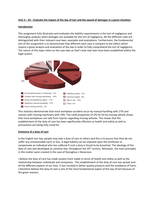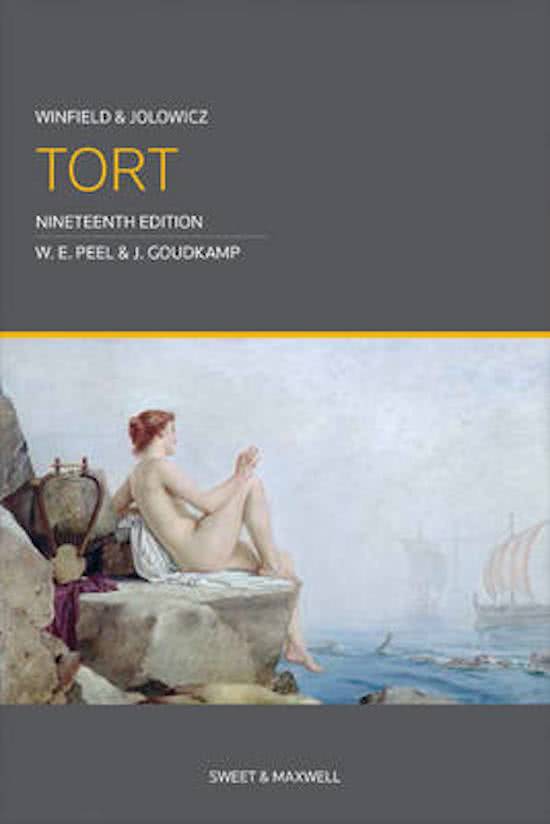Unit 3 – D1 - Evaluate the impact of the law of tort and the award of damages in a given situation.
Introduction
This assignment fully illustrates and evaluates the liability requirements in the tort of negligence and
thoroughly analyses when damages are available for the tort of negligence. All the different rules are
distinguished with their relevant case laws, examples and evaluations. Furthermore, the fundamental
aim of this assignment is to demonstrate how different each case is compare to the others which
require a great analysis and evaluation of the law in order to fully comprehend the tort of negligence.
The nature of this topic relies on the case laws as that’s how new laws have been established within the
legal system.
This statistics demonstrate that most workplace accident occur by manual handling with 27% and
contact with moving machinery with 19%. The small proportion of 2% for hit by moving vehicle shows
that most workplaces are safe from injuries regarding moving vehicles. This shows that the
establishment of the duty of care has been significantly effective as health and safety as well as
precautions are being fully cared for.
Existence of a duty of care
In the English tort law, people may owe a duty of care to others and this is to assure that they do not
suffer any unreasonable harm or loss. A legal liability can be imposed upon the tortfeasor to
compensate an individual who has suffered if such a duty is found to be breached. The ideology of the
duty of care was developed at common law, throughout the 20th century. Moreover, the main principles
in this matter were created in the case of Donoghue v Stevenson.
I believe the duty of care has made society more stable in terms of health and safety as well as the
relationship between individuals and companies. The establishment of the duty of care has spread over
all the different aspects of our lives. It has resulted in better quality products and the avoidance of harm.
I therefore believe the duty of care is one of the most fundamental aspect of the law of tort because of
the given reasons.
,Neighbor principle Donoghue v Stevenson
Neighbour principle was established as in the case of Donoghue v Stevenson, a woman succeeded in
establishing a manufacturer of ginger beer. However, the beer manufacturer negligently produced their
product. After this incident, the duty concept was developed further into a coherent judicial test. As a
matter of fact, the duty of care focuses on any reasonable harm that any person can undertake to
another, either physically or mentally. The test was then reformed to create the three-part test in the
case of Caparo v Dickman (1990).
Evaluation-details
Mrs Donoghue went to a café with a friend. The friend bought her a bottle of ginger beer but while
drinking the beer, a decomposed snail emerged from the bottle. Mrs Donoghue suffered personal injury
and she decided to put a claim forward against the manufacture of the ginger beer. The court held that
her claim was successful and this resulted in the establishment of the modern law of negligence and
created the neighbour test.
Lord Atkins stated that “The rule that you are to love your neighbour becomes in law you must not
injure your neighbour; and the lawyer's question” Who is my neighbour?" receives a restricted reply.
You must take reasonable care to avoid acts or omissions which you can reasonably foresee would be
likely to injure your neighbour. Who then in law is my neighbour? The answer seems to be persons who
are so closely and directly affected by my act that I ought reasonably to have them in contemplation as
being so affected when I am directing my mind to the acts or omissions which are called in question.”
From my perspective, what Lord Atkin is referring to is the concept of proximity when he stated
“persons who are so closely and directly affected by my act”. He also refers to the concept of the duty of
care when he mentions that “you must not injure your neighbour and you must avoid acts or omission
which you can reasonably foresee”. This is also demonstrating that if you can foresee a risk, you should
avoid attempting an act that might result in someone’s harm.
I believe that the fundamental issue with the case of Donoghue v Stevenson (1932) relies upon the
ambiguity that who should take the responsibility for Mrs Donoghue’s injury. The Café had a duty of
care to its consumers, the company has a duty of care to the consumers and the friend had a duty of
care to Mrs Donoghue. I believe that the concept of foreseeability can come to the surface in order to
resolve this ambiguity. We must first tackle the problem with Mrs Donoghue’s friend because she was
the closest person to her at the time of the incident (proximity) and she was the person who bought the
drink for her. However, what matters here is that she couldn’t have possibly foresee such a risk coupled
with the fact that she did not have any role in making the beer. Therefore, the ambiguity with the duty
of care is now only a matter discovering whether it was the company’s negligence or the café’s issue
with health and safety. The court has the role to find out who is responsible and the evidence suggested
that it was the company’s negligence in producing the beers.
The breach of the duty of care took place where the company negligently produced its products. The
reason lies behind the importance of foreseeability; the members of the company were the only ones
who could have taken an extra care in order to assure that their products are safe to consume. More
importantly, it was the company who could have foreseen a risk of injury and therefore they are liable
for the breach of the duty of care. However, I believe that the café should have been inspected as well
as the company because something could have affected the drink while they were being stored.
, The damage of this act of negligence is Mrs Donoghue’s injury and perhaps many more who did not
consider making a claim against the company. However, was it fair, just and reasonable to impose
liability on the company that produced the beers? There might have been some other factors that
resulted in the presence of the snail such as how it was transported, the temperature or even where the
café stored them.
Comment on the neighbour statement by Lord Atkins (reference: McFarlane v Tayside Health Board
(2000), D v East Berkshire Community NHS Trust and others [2003] and Vowles v Evans and Welsh
Rugby Union Ltd (2003)
The courts encountered many circumstances where there was a necessity to refine and elaborate on the
neighbour principle’s basis thesis. For instance, in the case of Hedley Byrne & Co Ltd v Heller & Partners
Ltd (1964), an issue was raised regarding negligence. However, there wasn’t an act or omission which
made the courts to reconsider the neighbour principle. The House of Lords stated that “a plaintiff could
establish a duty of care only if it could be shown that a special relationship subsisted between the
parties. What the House of Lords meant by “special relationship” was that, as being one of close
proximity broadly equivalent to a contractual relationship. Therefore the neighbour principle also
requires the consideration of the test based on foreseeability, proximity and that any decision made
must be just, fair and reasonable if the court wish ti impose liability on the defendant. Other cases such
as McFarlane v Tayside Health Board (2000), D v East Berkshire Community NHS Trust and others [2003]
and Vowles v Evans and Welsh Rugby Union Ltd (2003) have illustrated that there is always a necessity
to consider the relationship between the parties as well as the neighbour principle
In conclusion, I believe this decision made by Lord Atkins is fair for some cases that require certain
elements. However, other factors must be considered for future cases which in practise means using the
Caparo test as a mean of assuring that justice is implemented. The concept of proximity should be
further emphasised as there might be a significant distance between the parties but liability could still
be imposed. This is applicable for companies operating in Europe exporting products to the UK. I
therefore, believe that his decision is fair for the time of the incident but the Caparo test and other
factors must be considered for current cases. Furthermore, every case is unique and requires different
approaches therefore we must not use the literal rule but should open the doors of interpretation and
even allow changes to occur for the law if appropriate.
Caparo test
The test focuses on three elements that must be considered.
1) “It was reasonably foreseeable that a person in the claimant’s position would be injured.”
2) “There was sufficient proximity (closeness) between the parties.
3) ” It is fair, just and reasonable to impose liability on the defendant”
Not Foreseeable
This matter became important in the case of Bourhill v Young (1943). In this case a motorcyclist with a
very high speed crushed into a car and died in the scene. However, Mrs Bourhill who was eight month
pregnant was about 50 yards away from the place where the incident occurred. Furthermore, she did
not see the incident but heard about it. Furthermore, as she saw blood on the road, she suffered shock
and her baby was stillborn. Following this, she sued against the motorcyclist’s estate but the court made





